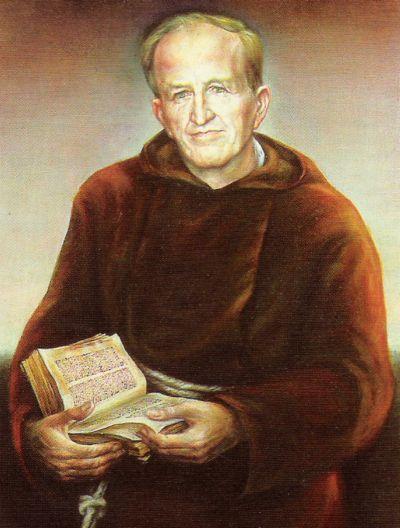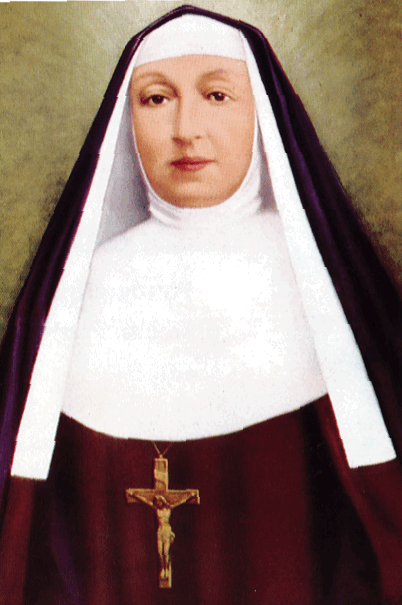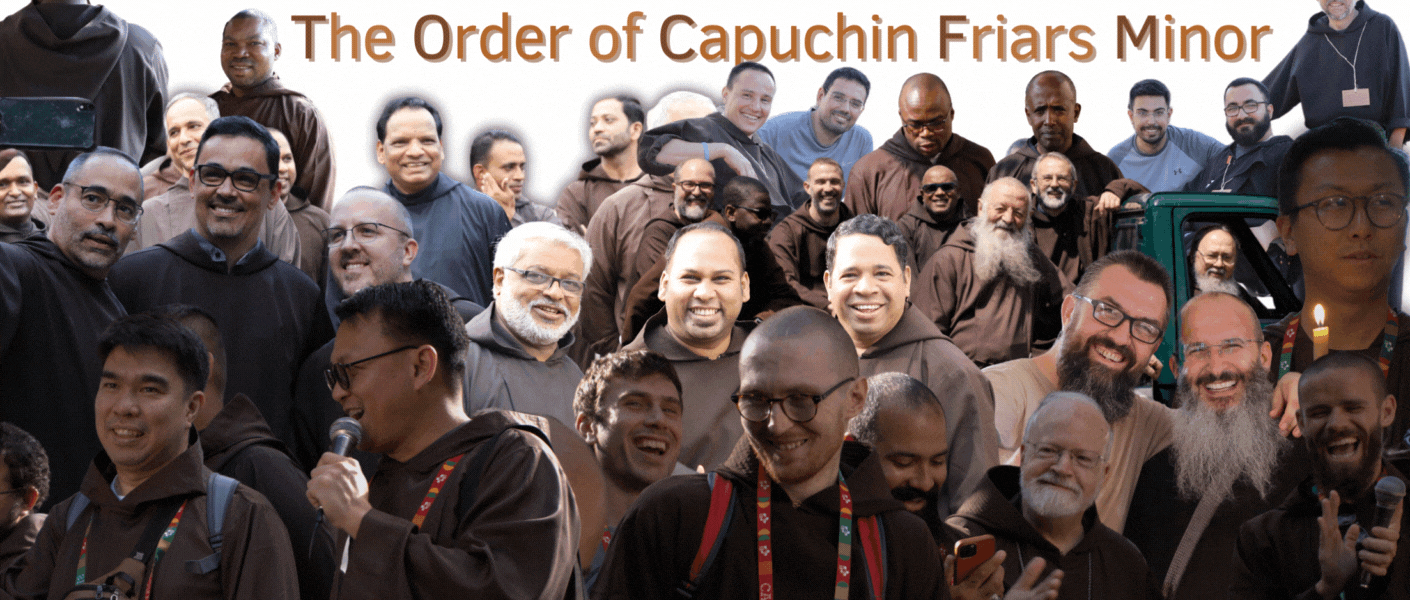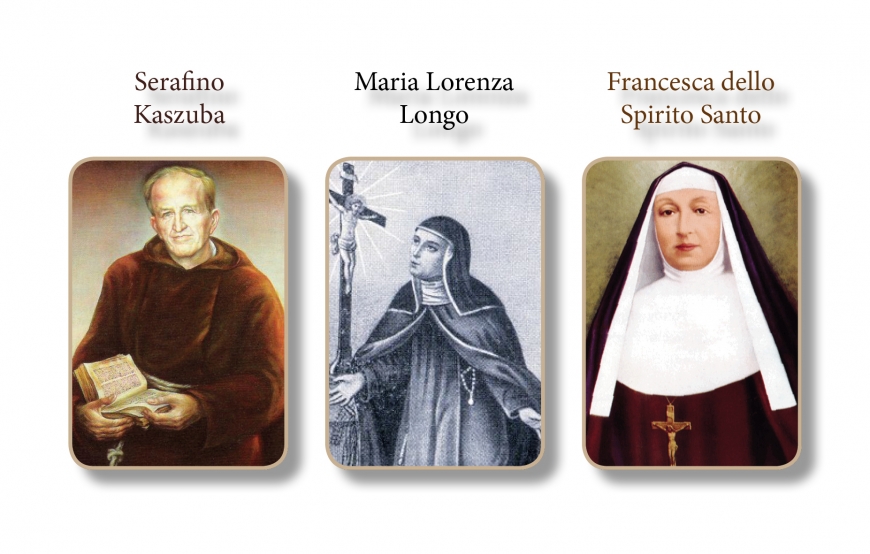Three new venerables: Seraphim Kaszuba, Maria Lorenza Longo, and Frances of the Holy Spirit
- Published in Other news items
On September 26, 2017, the ordinary session of the cardinals and bishops of the Congregation for the Causes of Saints recognized the heroic virtue of the Servants of God Seraphim Kaszuba (Alojzy Kaszuba) (1910-1977), Capuchin friar of the Province of Krakow, Maria Lorenza Longo (1463-1539), Capuchin Poor Clare foundress, and Mother Frances of the Holy Spirit (Caroline Baron) (1820-1882), foundress of the Franciscaines du Saint Esprit de Montpellier. On October 9 Pope Francis authorized the Congregation to issue the relative decrees.
Seraphim Kaszuba, 1910-1977

Alojzy Kazimierz Kaszuba was born on June 17, 1910 in Lviv, then in Polish territory but now in Ukraine, to Karol, a worker, and Anna Horak, a homemaker, both of them Franciscan tertiaries. He began his schooling with the Capuchins, who cared for the parish. Finishing school, against the wishes of his mother, he asked to be admitted to the Capuchin friars on June 3, 1928. Soon after he began the novitiate in Sędziszów Małopolski and was given the name of Br. Seraphim, even though he would have preferred Stanislaus.
Moving to Krakow on September 10, 1929, Br. Seraphim professed temporary vows and then made his perpetual profession in 1932. On March 11, 1933, in the Capuchin Church in Krakow, he was ordained priest by the laying on of hands and prayer of consecration of Bishop Stanisław Rospond.
Along with the ordinary pastoral and ministerial work, Br. Seraphim was given the obedience to study Polish philology at the philosophy department of the Jagiellonian University, graduating June 17, 1939. His first pastoral assignment was the Capuchin student house in Razwadów and the care of the Capuchin publications The Seraphic Ascent and Peace and Good.
At the outbreak of the Second World War on September 1, 1939, the Servant of God was in Lviv helping his mother who would pass away on April 1, 1940. It was there that he heard the news of the German invasion of Poland and experienced the invasion of eastern Poland and Lviv by the Red Army.
After his mother’s death, Br. Seraphim accepted the invitation of his confrere Bolesław Wojtuń and moved to Ludwipol in Volhynia, beginning a pilgrimage from parish to parish, village to village, to make up for the absence of priests. In this he was also fleeing the constant threat of death because he was under the close surveillance of the UPA, the Ukrainian Insurgent Army.
At Christmas 1940 he was at Karasyn in Volhynia, but the opening of the German-Russian front caused the destruction of the larger part of the villages of the region. Without losing heart, together with his parishioners, Br. Seraphim took refuge first in Bystrzyca and then in Dermanka.
In December 1941 Br. Seraphim was arrested by Ukrainian militia on the false accusation of possessing weapons and a radio. Released on Christmas Eve, he began to visit the Polish families in areas by then under Soviet control.
In November 1943, during one of the attacks of the UPA, he ventured away from Emilczyn and took refuge in Stara Huta, in the territory of the Army of the Polish Resistance, where there were also present 8,000 Catholic refugees.
In Spring 1944, after the German retreat, the Red Army entered Volhynia a second time. Then, following the Yalta Conference, there began the time of deportation. The Servant of God too would have had to have been repatriated, but on August 11, 1945 he left the repatriation train and decided to stay in Volhynia. Thus, from August 1945 until April 1958 Br. Seraphim was a pastor, recognized by the communist authorities, of a parish that extended for many square kilometers.
On April 11, 1958 the communist government deprived Br. Seraphim of his priestly rights, at the same time closing all the churches of Równe, Zdolbunów, Ostróg, and Sarny. Though asked by the government to leave Soviet territory, Br. Seraphim, with the support of the Christian community, continued his apostolate, now illegal. He left Równe, first going to Sambor and then to Kazakhstan, ending up in Crimea at Christmas 1961, before being in Kiev and then Leningrad, where he remained until 1963 until departing for Latvia.
On March 6, 1966 Br. Seraphim was arrested for ‘vagrancy’ and sentenced to five years of exile in Arykty, Kazakhstan, and on the following August 6 was transferred to Arszatynsk, where he worked in a bakery. His health, already tested by his earlier pastoral effort and now by the heavy work of bookbinding, stoking in a hospital, and as apothecary, became delicate such that he could no longer work.
On November 16, 1966 the sentence of exile was revoked and Br. Seraphim was able to get to Astana, where he took up again his pastoral work. Then on December 22 of the same year he was arrested again and sentenced to eleven years imprisonment in a home for the elderly, handicapped, and deaf at Mala Timofijewka. In February 1968 he escaped and resumed his clandestine apostolate.
On August 7, 1968, having heard of the death of his sister Maria, Br. Seraphim sought to return to Poland, arriving only on the 19. After having visited Krakow he reached the friary of Wrocław where he intended to stay only briefly, but his state of health forced him to stay in Poland until June 13, 1970, when, having recovered and obtained the necessary permissions, he returned to Kazakhstan. Two episodes from this period are noteworthy: in the small Kazak town of Taincza the authorities gave permission for a chapel to be built but with the tacit order that Br. Seraphim never offer Mass there. The Christians of the place followed the command, even though they otherwise continued to welcome Br. Seraphim. Also in these years Br. Seraphim went to small town in Uzbekistan because the local priest there had become a disciple of Bishop Marcel Lefebvre.
On September 19, 1977, on their way back to Lviv after traveling to Rowne, the car in which Br. Seraphim and others were traveling broke down and the passengers had to make the rest of the trip on foot in bad weather. A Ukrainian Catholic lady took Br. Seraphim in as a guest, but during the night of September 20, 1977 he passed away in the room where he was staying, sitting in a chair and bent over his breviary. The funeral was held on September 22, 1977 and Br. Seraphim was buried in the Janowski cemetery in Lviv.
Maria Lorenza Longo, 1463-1539

Five hundred years later the works of Servant of God Maria Lorenza Longo continue to give glory to God and are a sign of his goodness to his children.
The institutions of her founding, such as the Santa Maria del Popolo hospital for incurables and the proto-monastery of the Order of Capuchin Poor Clares, called St. Mary in Jerusalem, continue to shine with lively beauty, charity, prayer, and contemplation in the Church of Naples and of the world.
Maria Lorenza Longo was born in Lleida, Catalonia around 1463. She married Joan Llonc (Longo), a Valencian, and had three children. Around 1480, she was poisoned by one of her servants during a ball and become paralyzed in her hands and feet. In 1506, after a discernment accompanied by much prayer and on the advice of a hermit, she went to Naples with her husband, who was regent of the chancery of King Ferdinand II of Aragon ‘the Catholic’. Her husband died prematurely in 1509.
According to her wishes, Maria Lorenza was then brought on a pilgrimage to the Shrine of Loreto where she was cured miraculously during the celebration of Holy Mass. Upon her return she decided to dedicate herself to the poor and the sick at the entrance of San Nicolo al Molo. In 1519, at the invitation of Ettore Vernazza, Genovese notary and founder of the Society of Divine Love, she took up, by divine inspiration, the project of the hospital for incurables in Naples, which was constructed on its current site in 1522.
After assisting the sick for thirteen years, and while under the direction of St. Cajetan, Maria Lorenza, though she wanted to go the Holy Land in pilgrimage, acquiesced to the wish of the Lord for the founding of a monastery of virgins in Naples, which she did with some friends. Amidst many trials, but with the encouragement of Cardinal Andrea Matteo Palmieri, Maria Lorenza obtained from Pope Paul III the bull of foundation for the monastery of St. Mary in Jerusalem, Debitum pastoralis officii. The monastery would be under the rule of St. Clare of Assisi and the Constitutions and norms of enclosure of St. Colette of Corbie. Thus twelve nuns made their religious vows together and opened the possibility for many young women of more humble means to respond to the contemplative vocation. The following year the number was fixed at thirty-three, the number by which the monastery of the Capuchin Poor Clares is known to this day. (Le Trentatré)
In 1538, by a papal motu proprio, the monastery was entrusted to the care of the Capuchins.
Maria Lorenza Longo died in 1539.
Appreciated by both popes and bishops, including St. Charles Borromeo, the new reform of Capuchin women expended into all of Italy, Spain, and France, and even reached the new world with foundations in North and South America.
Today, after five hundred years, the Santa Maria del Popolo hospital for incurables continues its work, and the Order of Capuchin Poor Clares, which recognizes Maria Lorenza Longo as its foundress, counts about two hundred monasteries all over the world. About ten Capuchin Poor Clare nuns have been recognized as saints and blesseds.
Frances of the Holy Spirit, 1820-1882

Caroline Pauline was born on December 12, 1820 in Mailhac, in the French region of Languedoc-Roussillon-Midi-Pyrénées, the first child of Antoine Baron and Françoise Rose Justine Granier. Her parents were her first teachers in the faith and while she was still little she was encouraged to explain the catechism. Caroline attended the elementary school of the Sisters of Notre Dame in Narbonne from 1825 to 1830 and then studied with the Sisters of St. Joseph of Lyon in Saint-Pons. At age twelve she received her first Holy Communion.
After receiving her teaching degree, moved by a religious vocation, on September 24, 1836 Caroline was admitted to the Sisters of St. Joseph. After making her perpetual profession in 1840 she was assigned to teaching at Montpeyroux. Given her great success, in 1847 she was entrusted with the sisters’ most important school in Bédarieux, where she served until 1851. Her successes drew suspicions and calumnies from certain sisters which led to the general council of the Congregation to move Caroline to another province and to transfer her to Mailhac, where she was appointed assistant and then mistress of novices.
In 1856 she was asked to found a school in Lézignan, near Mailhac, located in an old monastery of Poor Clares that had been suppressed during the Revolution. Along the way from the house to the school there was a chapel that had belonged to the Franciscan Third Order, and Caroline began to stop there to pray. It was there that she first met and began to live a Franciscan spirituality and began to practice the Way of the Cross with greater intensity.
Dividing her time and work between the novitiate in Mailhac and the school in Lézignan, the Servant of God attracted the appreciation of students and families alike, as well as the esteem of the clergy for her effective assistance in the formation of boys. She was a complete success, praised at both the pedagogical and religious levels, but stirring up jealousies at the same time for the novelty of an apostolate that worked with boys.
The situation became so difficult and painful that the Servant of God felt the need to speak with the bishop, Charles-Thomas Thibault. As the ecclesiastical superior of the Sisters of St. Joseph, he asked her to remain in the habit but to leave the sisters and to stay with family until he could give her further instructions. Then, in May 1859 the bishop directed her to an institute where she was able to continue her apostolate. During this time Caroline met Fr. Louis Faurie, the pastor of Rayssac-sur-Lampy, a Franciscan tertiary himself who enrolled her in the Franciscan Third Order on October 11, 1860, invested her in the ‘habit of penance’, and gave her the name Frances of the Holy Spirit.
Fr. Faurie also introduced Frances to the Jesuit Fr. Clément Cathary, who was about to leave for Madagascar, and to the Franciscan Observant Fr. Léon de Clary. On their advice and with the support of the Capuchin Friars of Toulouse, the Servant of God set herself to founding a new religious congregation.
The institute of the Franciscan Tertiaries of Montpellier received the approval of Bishop Thibault on December 16, 1860. Frances and three sisters were authorized to set up a house in Saint-Chinian beginning on April 3, 1861. On April 4 the cross was enthroned in the garden of the new house and on the next day a school was opened with thirty students. The new Congregation was aggregated to the Order of Friars Minor Capuchin in 1866.
Frances of the Holy Spirit had been named General Superior by Bishop Thibault in 1861, and was unanimously reelected by subsequent General Chapters. Soon after the Chapter of 1878, however, she began to show signs of illness and the sisters recommended that she take some time for rest and care in Lamalou-les-bains. Unfortunately, there was no improvement in four years of repeated illness.
On Christmas night in 1882, the Servant of God assisted at Holy Mass and wished to greet all the sisters personally and sing a song with them. In the morning she received the last sacraments and then passed away on December 28, the feast of the Holy Innocents, at two o’clock in the morning.


